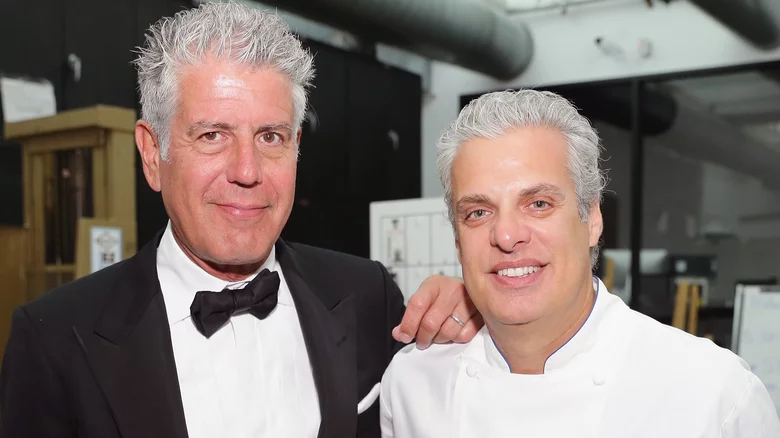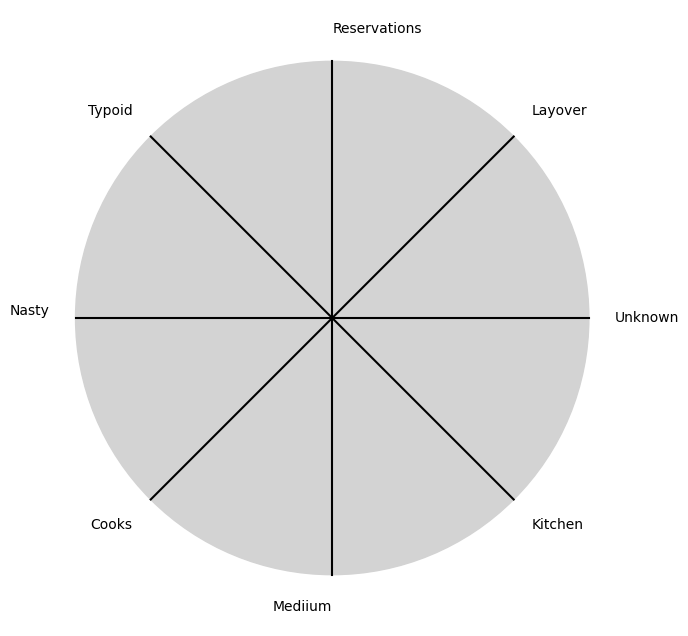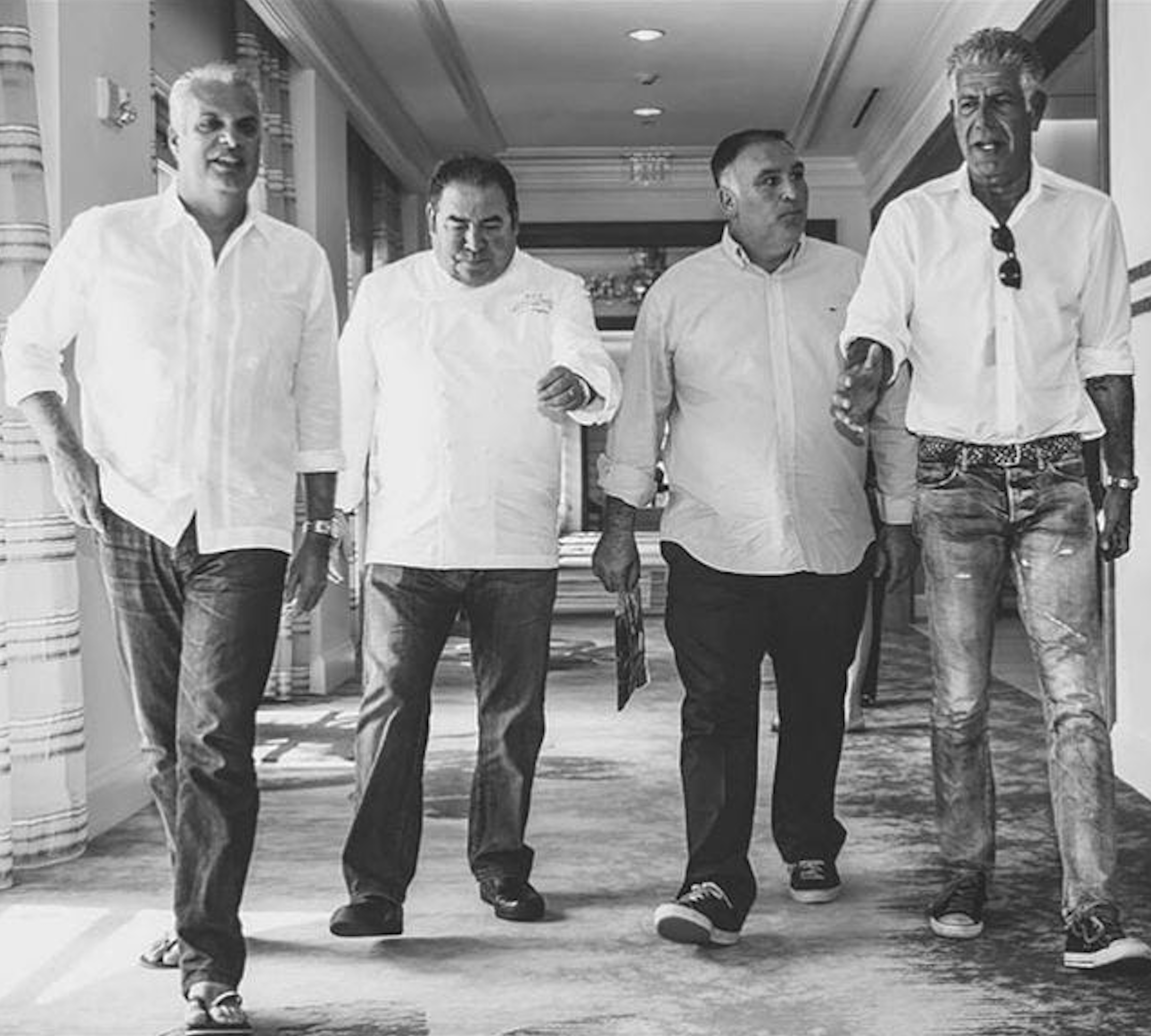Tony#

Like all good performances, it’s about timing, tone, and delivery – like cooking
1. f(t)
\
2. S(t) -> 4. y:h'(t)=0;t(X'X)X'Y -> 5. b -> 6. SV'
/
3. h(t)
Allegory#
ii: \(\mu\) Timing#
Marriages: 20y, 9y, 0y (Paradise lost)
Addictive personality before
44yLet’s put it in one word: inferno!
Show code cell source
import matplotlib.pyplot as plt
import numpy as np
# Clock settings; f(t) random disturbances making "paradise lost"
clock_face_radius = 1.0
number_of_ticks = 8
tick_labels = [
"Kitchen", "Mediium", "Cooks", "Nasty",
"Typoid", "Reservations", "Layover", "Unknown"
]
# Calculate the angles for each tick (in radians)
angles = np.linspace(0, 2 * np.pi, number_of_ticks, endpoint=False)
# Inverting the order to make it counterclockwise
angles = angles[::-1]
# Create figure and axis
fig, ax = plt.subplots(figsize=(8, 8))
ax.set_xlim(-1.2, 1.2)
ax.set_ylim(-1.2, 1.2)
ax.set_aspect('equal')
# Draw the clock face
clock_face = plt.Circle((0, 0), clock_face_radius, color='lightgrey', fill=True)
ax.add_patch(clock_face)
# Draw the ticks and labels
for angle, label in zip(angles, tick_labels):
x = clock_face_radius * np.cos(angle)
y = clock_face_radius * np.sin(angle)
# Draw the tick
ax.plot([0, x], [0, y], color='black')
# Positioning the labels slightly outside the clock face
label_x = 1.1 * clock_face_radius * np.cos(angle)
label_y = 1.1 * clock_face_radius * np.sin(angle)
# Adjusting label alignment based on its position
ha = 'center'
va = 'center'
if np.cos(angle) > 0:
ha = 'left'
elif np.cos(angle) < 0:
ha = 'right'
if np.sin(angle) > 0:
va = 'bottom'
elif np.sin(angle) < 0:
va = 'top'
ax.text(label_x, label_y, label, horizontalalignment=ha, verticalalignment=va, fontsize=10)
# Remove axes
ax.axis('off')
# Show the plot
plt.show()
Show code cell output

V7: \(\sigma\) Qualities#
Author, TV host, Celebrity, Divorce
s(Inferno)
i: \(\%\) Delivery#
Creative-destruction, yin & yang, nihilism & creativity (‘Urgatorio’)
Femme-fatale,
#metoo ambassador, moralisism, frailty, decline

Ceci n’est pas une figure. Sink of F# as za “French Connection”. It will be a fixed note as a chord progression drives through the entire circle of fifths, beginning with a very traditional ii-V7-I. The chord-progression, the MQ-TEA, are incidents in Anthony Bourdin’s life. One of the incidents is Eric Ripert (aka Za Ripper), a stable, classical, element in the unstable, romantic, chaos of our beloved Tony’s life.#
Essays#
1 ii-V7-i#
Yes, that sequence does resemble modal interchange, but in a narrative or thematic sense rather than a musical one. Each of these shows represents a shift in tone, focus, and exploration while retaining Anthony Bourdain’s signature approach to storytelling and exploration.
“A Cook’s Tour” (Food) was primarily centered around food as a lens through which culture and life were explored. It had a relatively straightforward and sometimes playful approach, with Bourdain as the curious chef exploring culinary traditions.
“No Reservations” (Travel) expanded the scope to include more of the travel experience itself. It still focused heavily on food but began to delve deeper into the cultural and social aspects of the places Bourdain visited. The show became more about the journey and the places, with food as a key component rather than the sole focus.
“Parts Unknown” (General) took this evolution further, broadening the scope to include more profound explorations of culture, politics, and the human condition. While food was still important, it became part of a larger narrative about the world and its complexities. Bourdain’s role shifted from chef to cultural commentator, and the show’s tone often ventured into more serious and reflective territory.
This progression reflects a kind of “modulation” in Bourdain’s work, moving from a specific focus (food) to a broader exploration of life and culture. It’s a journey of deepening complexity, much like how modal interchange in music can shift the mood or key, creating new emotional landscapes while maintaining a connection to the original theme.
2. Effortless Cadence#
Anthony Bourdain’s career progression—from “A Cook’s Tour” (ii) to “No Reservations” (V7) to “Parts Unknown” (i)—can be likened to an effortless cadence, a smooth and natural resolution that characterizes his journey as a storyteller. Just as a cadence in music brings a phrase to a satisfying close, Bourdain’s seamless transition from one phase of his career to the next felt organic and unforced.
At 44 years old, a time when many might consider themselves well into the arc of their career, Bourdain was just beginning to find his stride. The transition from a chef with a single book to a global cultural icon was as smooth as the glide from a dominant chord to the tonic in a well-resolved cadence. He didn’t just change shows; he evolved the very nature of his storytelling, broadening the scope of his narrative while maintaining the core of who he was—curious, irreverent, and deeply human.
This “effortless cadence” in his life is emblematic of how Bourdain navigated the complexities of fame and personal growth. He never lost the sense of wonder that made his work resonate so deeply with audiences worldwide. Even as he faced the harsh realities of his own life, such as finally securing health insurance and opening his first savings account at 44, his narrative voice remained assured, like a musician who has mastered their craft and can resolve even the most dissonant chords with grace and ease. In the end, Bourdain’s legacy is one of continuity, marked by a life lived with an intuitive understanding of the world’s rhythms—a cadence that resonates long after the final note has been played.
3. Coming Soon …#


